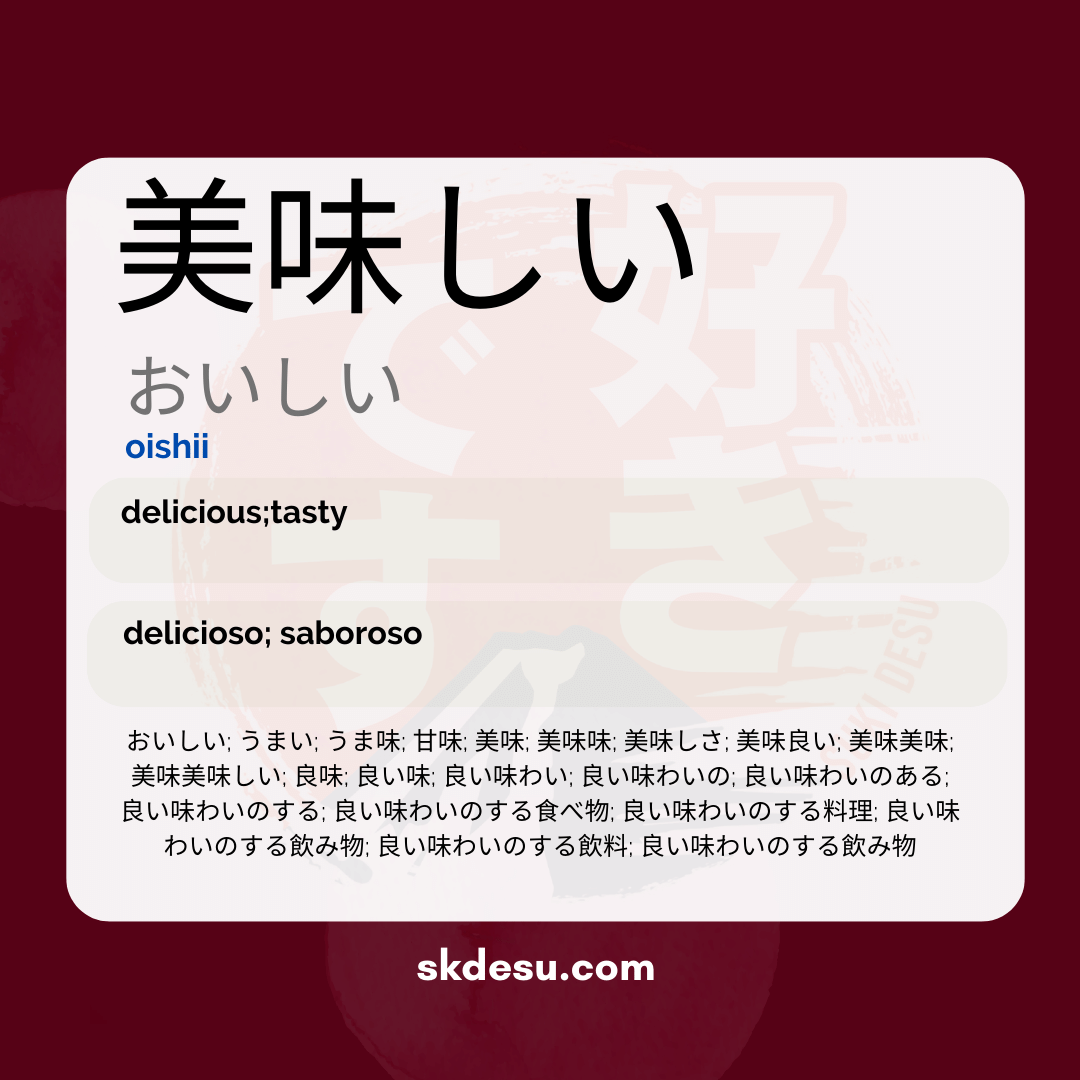Translation and Meaning of: 美味しい - oishii
If you are learning Japanese or have an interest in the language, you may have come across the word 美味しい (おいしい). It is one of the most common expressions in daily Japanese life and carries a meaning that goes beyond a simple translation. In this article, we will explore what this word represents, its origin, how it is used in everyday life, and some curiosities that can help you memorize it. Whether to enrich your vocabulary or better understand Japanese culture, this guide will show you why おいしい is so special.
The meaning and translation of 美味しい (おいしい) is "delicious."
The word 美味しい (おいしい) is generally translated as "delicious" or "tasty," but its use goes beyond that. It conveys a genuine pleasure when eating or drinking something, expressing satisfaction and appreciation for food. Unlike more neutral terms like うまい (umai), which can also mean "good," おいしい has a more polished tone and is common in everyday conversations.
It's worth noting that 美味しい is often written in hiragana (おいしい) in informal texts, while the kanji version (美味しい) appears in more formal contexts or on menus. This flexibility in writing does not change the meaning but demonstrates how the word adapts to different situations.
The origin and etymology of おいしい
The word おいしい has ancient roots in the Japanese language. Some linguists suggest that it may have originated from the term おいし (oishi), which was already used during the Heian period (794-1185) to describe something pleasant to the taste. Over time, the ending しい (shii) was added, giving a more emphatic and emotional tone to the expression.
The kanji used in 美味しい also provide clues about its meaning. The first character, 美, means "beauty," while 味 represents "flavor." Together, they form the idea of "beautiful flavor" or "food that pleases both the palate and the senses." This combination reinforces why the word is so commonly used to praise well-prepared dishes.
How おいしい is used in everyday Japanese
In Japan, saying おいしい is more than a simple compliment about food – it is a way to show gratitude to the person who prepared the meal. In families or restaurants, it is common to hear this expression as a gesture of politeness and appreciation. In informal contexts, Japanese people also use variations like めっちゃおいしい (meccha oishii – "really delicious") to emphasize the flavor even more.
Another interesting detail is that おいしい is not limited to food. In some situations, it can be used metaphorically to describe advantageous opportunities or pleasant situations, such as in "おいしい話" (oishii hanashi – "a profitable deal"). However, this usage is less common and depends on the context.
Tips for memorizing and using おいしい correctly
An effective way to remember おいしい is to associate it with moments of culinary pleasure. For example, when you try a dish you liked, mentally repeat "おいしい!" to create an emotional connection with the word. Another tip is to practice with simple sentences like "このケーキはおいしいです" (Kono kēki wa oishii desu – "This cake is delicious").
If you already watch animes or Japanese dramas, pay attention to how many times the characters use おいしい in meal scenes. This natural exposure to the term helps internalize its meaning and pronunciation. Over time, it will become one of the first words that come to mind when savoring something truly delicious.
Vocabulary
Expand your vocabulary with related words:
Synonyms and similar words
- おいしい (oishii) - Delicious
- うまい (umai) - Delicious, excellent (common in informal conversation)
- うま味 (umami) - Umami (pleasantly savory flavor)
- 甘味 (kanmi) - Sweet flavor
- 美味 (biwi) - Delicious (more formal way)
- 美味しさ (oishisa) - Quality of being delicious
- 良味 (ryoumi) - Good flavor
- 良い味 (yoi aji) - Good taste, pleasant flavor
- 良い味わい (yoi ajiwai) - Good appreciation of flavor
Related words
Romaji: oishii
Kana: おいしい
Type: Adjective, noun
L: jlpt-n1, jlpt-n5
Translation / Meaning: delicious; Tasty
Meaning in English: delicious;tasty
Definition: Good taste and delicious.
Quick Access
- Vocabulary
- Writing
- Sentences
How to Write in Japanese - (美味しい) oishii
See below a step-by-step guide on how to write the word by hand in Japanese. (美味しい) oishii:
Example Sentences - (美味しい) oishii
See below some example sentences:
Mitsu wo kakete taberu to oishii desu
It is delicious to eat with honey.
- 蜜 - honey
- を - object particle
- かけて - Verb "colocar" in the gerund
- 食べる - Verb "to eat" in the infinitive
- と - Comparison particle
- 美味しい - Adjective "delicious"
- です - Verb "to be" in the present
Kararanai oishisa desu
It is an unbearable delight.
It is an unbearable flavor.
- 堪らない - unbearable, intolerable
- 美味しさ - delicious, delicious taste
- です - yes, it is
Other Words of this Type: Adjective, noun
See other words from our dictionary that are also: Adjective, noun

